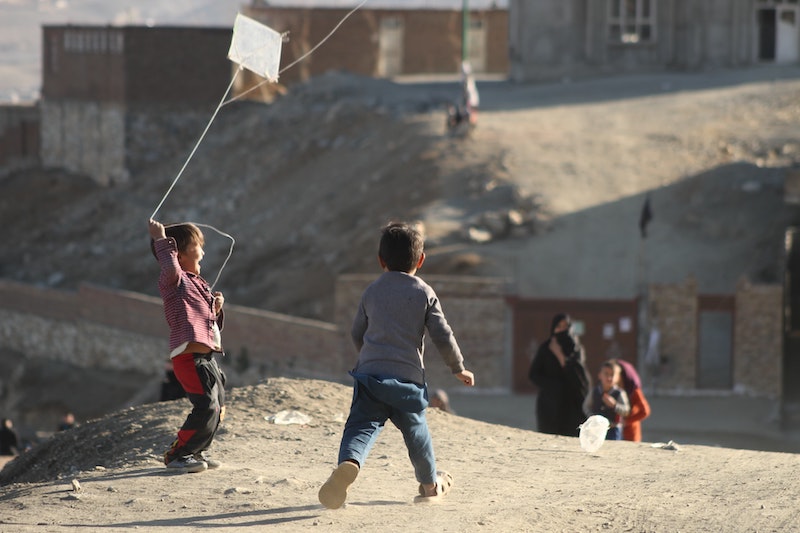Addressing Child Poverty in Afghanistan

According to UNICEF, more than 50% of Afghanistan’s people (24.4 million) require humanitarian aid, including 12.9 million Afghan children. The effects of the COVID-19 pandemic and the Taliban takeover following the U.S. withdrawal from the country have only aggravated child poverty in Afghanistan.
An Overview of Child Poverty in Afghanistan
In August 2021, UNICEF Afghanistan representative, Hervé Ludovic De Lys, described the situation of child poverty in Afghanistan as “A child protection crisis in a country already one of the worst places on earth to be a child.” Child poverty in Afghanistan has been prevalent for decades, as a result of conflicts, violence and instability.
Child poverty can have lifelong consequences for children, including a loss of opportunities. Considering that more than 50% of Afghanistan’s population is younger than 18, it is imperative to measure child poverty. In particular, measuring multidimensional poverty is important because it takes into account monetary poverty along with the “other aspects of well-being and the fulfillment of human rights and child rights.”
Based on data from 2016-2017, the Afghanistan Multidimensional Poverty Index (A-MPI) indicated that more than 56% of Afghan children between the ages of 0 and 17 endured multidimensional poverty. Additionally, according to Al Jazeera, by November 2021, 3 million Afghan children under the age of 5 faced the risk of starvation.
Economic Impacts After US Withdrawal
According to statistics from World Bank in 2020, Afghanistan stood as the sixth most impoverished country in the world based on its gross national income per capita of $500. Due to the COVID-19 pandemic and the power transition to the Taliban, the Afghanistan economy began to collapse drastically in August 2021.
After the Taliban took over the Afghanistan government in 2021, countries, including the United States, cut off foreign aid to the nation. Because the economy of Afghanistan primarily revolved around foreign aid (75%), the country could not manage to maintain economic stability without any financial support.
Effects of Child Labor
A survey published in February 2022 by Save the Children analyzed “1,400 households across seven provinces of Afghanistan.” The survey shows that 82% of Afghans endured losses of income after the Taliban came into power. As a result of these financial difficulties, 18% of households had to push their children into child labor — an estimated 1 million children are now in child labor in Afghanistan.
Afghan child laborers work “in the home-based carpet industry; as bonded labor in brick kilns; in the metal industry as tinsmiths and welders; in mines; in agriculture and on the streets as vendors, shoe shiners and beggars.” Poor working conditions jeopardize both the health and safety of these children. The consequences of child labor have lifelong impacts that affect children mentally and physically, restricting their fundamental rights and threatening their futures.
Education
Inger Ashing, CEO of Save the Children, highlighted the risk of the absence of child education in September 2020: “Children who lose out on education are more likely to be forced into child labor or early marriage and be trapped in a cycle of poverty for years to come.”
A 2018 UNICEF report indicates that an estimated 3.7 million Afghan children are out of school. However, since the Taliban takeover, in particular, tens of thousands of Afghan girls have lost their educational opportunities. Despite the Taliban’s promise at the beginning of its rule of allowing education for women and girls, on March 22, 2022, Afghan girls older than 12 had to return home — the Taliban shut down these girls’ schools until further notice.
Humanitarian Aid to Reduce Child Poverty in Afghanistan
In December 2021, UNICEF launched its largest single-country appeal of $2 billion for aid to Afghanistan. The aid aims to supply “water, sanitation, nutrition, education, health and protection services” to about 12.9 million Afghan children in desperate need of help.
UNICEF has provided assistance to Afghanistan for more than 70 years and recently scaled up its programs for women and children. UNICEF has also scaled up its child protection response by “providing child-friendly spaces and psychosocial support to children and their caregivers or parents.”
Considering the humanitarian crisis since the Taliban takeover, many countries reinstituted aid to Afghanistan. In March 2022, the United States government announced $204 million of further humanitarian assistance to Afghanistan, “bringing the total amount [to] more than $720 million since August 2021.” This funding will support scaled-up humanitarian initiatives of organizations such as UNICEF.
Although the issue of child poverty in Afghanistan is longstanding, with adequate foreign humanitarian aid and the help of international communities, the prospect of reducing child poverty in Afghanistan is optimistic.
– Youngwook Chun
Photo: Unsplash
